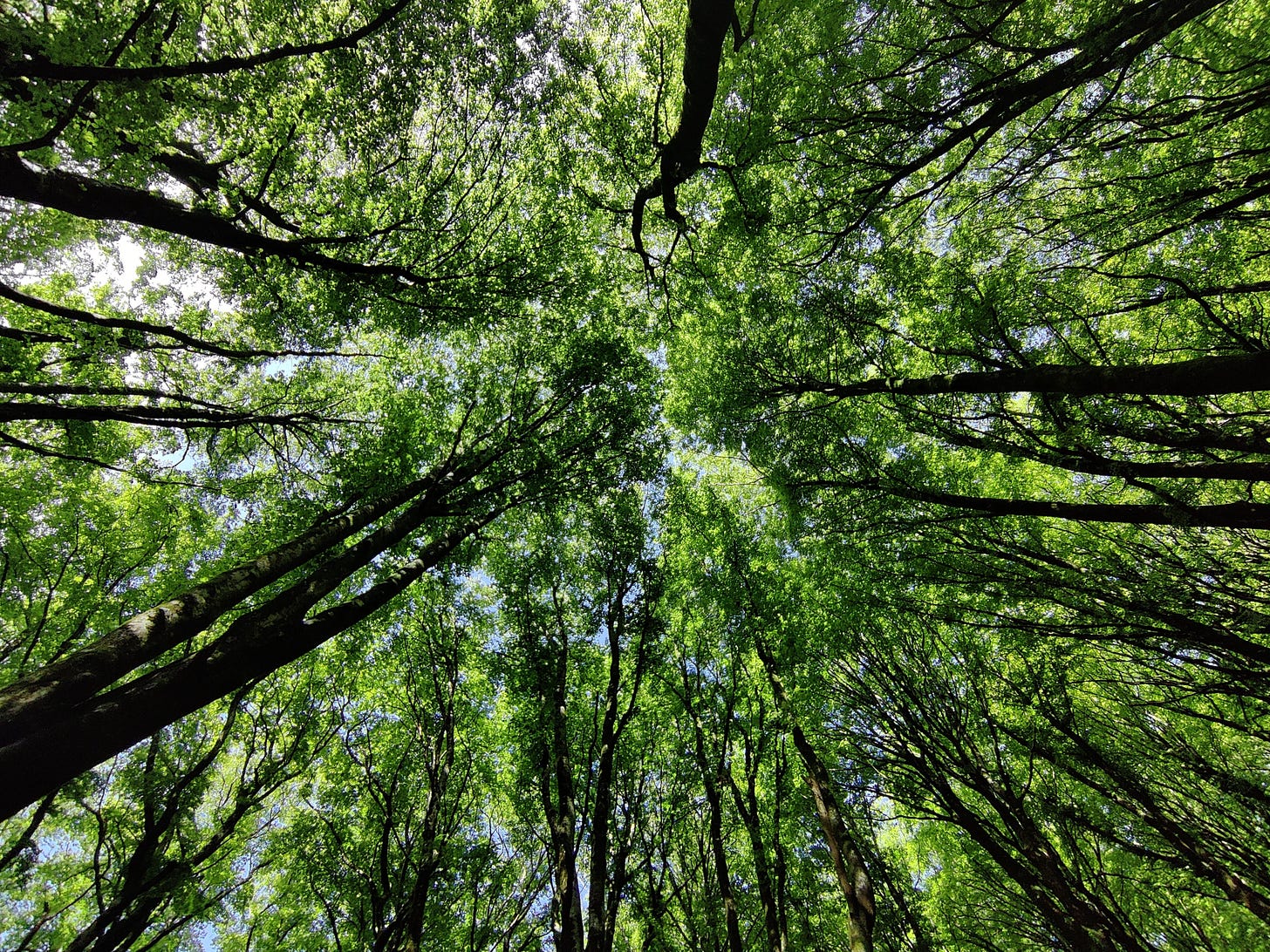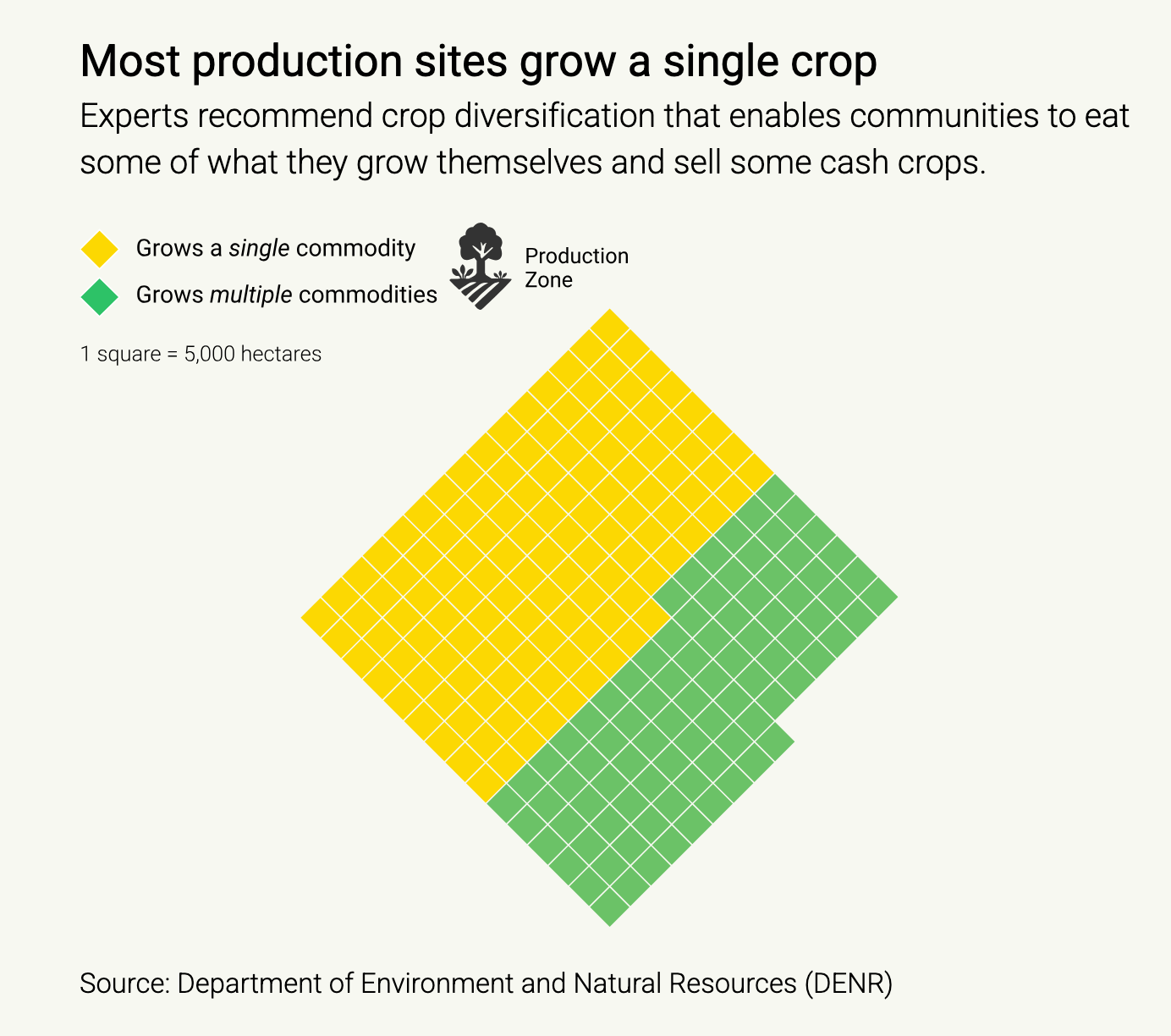Fifty Shades of Green
When a reforestation project go off course
Next week, I’ll be in Brasilia to facilitate One Planet Network’s 5th Global Conference of the Sustainable Food Systems Programme. If you’re attending it or will be in Brasilia and want to meet, or have tips on must-eat places, please drop me a line at thin@thin-ink.net.
I’m really excited to be a part of this important conversation and also to get a sense of what the COP30 host is planning for the climate negotiations, which are less than six months away.
Oh, my conversation with Jack Thompson, editor of Fodder, TABLE’s newsletter, is now available as a 30-minute podcast. You can listen to me talk about food systems in Southeast Asia in general and in my home country Myanmar in particular.
Now on to this week’s issue, which is about the state of forests in the Philippines and the world. We plan to investigate this issue in other parts of Southeast Asia so if you have any tips or ideas, please get in touch at thin@lightousereports.com.
The National Greenwashing Programme
For a long time, we were sold this idea that tree planting could be a “get-out-of-jail-free card” against climate change. Many grandiose projects to reforest different parts of the world were announced, to replace vast swathes of forest areas that were cleared for agricultural expansion, urban sprawl, and industrial activities.
But as we now know, mass-scale tree planting alone is nowhere near sufficient to tackle the climate and biodiversity crises we are experiencing today. Worse, poorly planned and managed programmes usually worsen the plight of local communities and does little to mitigate rising greenhouse gas emissions.
Instead, it can exacerbate the destruction of ecosystems - by introducing trees that are not indigenous or suitable to the area, for example - and leave gaping regulatory loopholes that profiteers can exploit.
Filipina journalist Lucelle Bonzo from Davao Today and data consultancy Thibi have been investigating the Philippines’ much-lauded National Greening Program (NGP) using a combination of traditional reporting with geo-spatial analysis to verify claims that the flagship project’s credentials are nowhere near as green as it has been portrayed. They planned a visual story that would be accessible to local communities.
Meanwhile at Lighthouse Reports, we’ve been interested in using remote sensing and machine learning to track how supposedly green programmes could actually be contributing to deforestation.
Thus Forest Fraud, a series on deforestation in Southeast Asia, was born. The region is home to the world’s third largest rainforest after Brazil and Congo but the issue has been largely invisible and underreported on a global scale.
With the EU deforestation regulation (EUDR) being enforced at the end of this year, however, there is an urgent need to better understand the state of forests in the region and the forces that are in play. You can read my pieces on EUDR here and here.
The story by Lucelle and Thibi, which has been gestating for over a year, was finally published this week. We hope to build on the amazing work they’ve done and plan more stories with them and other partners in Southeast Asia, so watch this space!
What is the National Greening Program (NGP)?
Launched in 2011, it’s one of world’s most ambitious regreening programmes in a country that has lost nearly 10 million hectares of forest between 1934 and 1988.
The loss was partly due to policies under the authoritarian regime of Marcos Sr. (his son Marcos Jr. is the current president) that promoted commercial logging for exports. Despite a nationwide logging ban and various regreening programs, our analysis found that on average nearly 177 hectares of trees have been felled every day for the last 20 years.
The NGP was supposed to fix these problems, with an initial goal of planting 1.5 billion trees across 1.5 million hectares within six years.
This has been expanded. It now has over 130,000 sites covering over 2 million hectares, with 1.8 billion seedlings planted, according to official numbers. A whopping $1 billion was spent between 2011 and 2019 on the project.
How is it supposed to work?
NGP is meant to “rehabilitate land scarred by decades of rampant logging through a consolidated government effort to either transform it into community-managed sustainable agro-forestry sites or by conserving and regrowing protected rainforests in order to reduce poverty; promote food security, environmental stability, and biodiversity conservation; and enhance climate change mitigation and adaptations”.
The trees would be a combination of indigenous rainforest and sustainable commodity crops cultivated by local communities.
It was to be a win-win-win for the environment, local communities, and for the Philippines.
How does it actually work?
An analysis of deforestation data derived from millions of satellite images over 100,000 NGP sites revealed that “one in every 25 hectares of NGP land experienced a major deforestation event: that is, instead of barren sites being reforested, the opposite occurs”.
“Forests are cleared right before or during regreening efforts. The sites are more often than not managed by communities with only short-term access to the land and at the time they would have been kicked off after three years.
“Communities mostly grow a single cash crop tied to the volatile global commodity markets and that does not generate steady income. Many of the designated protected areas have no trees at all, let alone thriving rainforests of indigenous species.”
The team also found that once you take away sites that have experienced major deforestation, sites where it's probable they neither contribute to greening nor sustainable local communities, and sites where the trees planted are not indigenous, you’re left with only 1 out of every 50 hectares designated for NGP that is actually fulfilling its original regreening purpose.
In other words, not at all how it should be.
Data analysis and number crunching was complemented by dogged on-the-ground reporting from Lucelle, executive director of Davao Today, who visited the two provinces with the highest tree cover loss in the past 20 years - Agusan del Sur in Mindanao and Palawan in Luzon.
Her interviews with civil society groups, local communities who are trying to make NGP work, and whistleblowers fed up with the massive discrepancy between its ambitions and its actual implementation, provided vivid accounts of where and how things went wrong.
For example, if community groups known as people's organisations wanted longer-term access to the land, like 25 years, they had to go through a daunting registration process that required both money and the understanding of complex bureaucracy, neither of which they have. Otherwise, they only have access for three years, not nearly enough time to take on proper stewardship of the land.
In Agusan del Sur, once you take away all the production sites not managed by a community group with tenure and all the sites with mono-cropping, only a small area was left where, in theory, community groups could sow, reap and harvest a sustainable mix of products over the long term as the NGP was envisioned.
Another example, Mount Mantalingahan Protected Landscape (MMPL) in Palawan, which has been on UNESCO’s Tentative List of World Heritage sites, showed that native forests were replaced with exotic timber in the name of conservation.
There are many more shocking details in the story, which I urge you to read over a large cup of morning tea or coffee.
Further reading
The story in Davao Today with all its data visualisation glory (pro tip: please scroll slowly to make sure you get the full effect)
The page on Lighthouse Reports describing the methodology in detail
Unprecedented Fires —-> Unprecedented Forest Loss
Speaking of trees, global forest loss surged to record highs in 2024, driven by a catastrophic rise in fires, which for the first time in 24 years surpassed agriculture as the leading cause of forest loss, said an annual analysis by Global Forest Watch.
In the past, fires accounted for 20% of forest destruction but this time around, it was responsible for nearly half, and they were devastating not only for those who were directly affected but also for the rest of the world.
“Globally, the fires emitted 4.1 gigatonnes of greenhouse gas emissions... more than 4 times the emissions from all air travel in 2023,” said the World Resources Institute (WRI), which set up Global Forest Watch.
“Loss of tropical primary forests alone reached 6.7 million hectares — nearly twice as much as in 2023 and an area nearly the size of Panama, at the rate of 18 soccer fields every minute,” it added.
Despite a pledge in 2021 to halt and reverse forest loss by 2030, the world is “alarmingly off track”.
“Of the 20 countries with the largest area of primary forest, 17 have higher primary forest loss today than when the agreement was signed.”
The loss of forests in 2024 alone caused 3.1 gigatonnes of emissions, which is a little more than the annual CO₂ emissions from India’s fossil fuel use.
Which countries are the most affected?
Brazil: accounted for 42% of all tropical primary forest loss, with the worst drought on record responsible for 66% of that loss. Primary forest loss from other causes also rose by 13%, mostly due to large-scale farming for soy and cattle, though this is still lower than the peaks seen in the early 2000s and in the Bolsonaro era.
Bolivia: forest loss `rose by 200%, coming second only to Brazil and overtaking DR Congo despite having less than half the latter’s forest area. “More than half the loss was due to fires, often set to clear land for soy, cattle, and sugar cane, which turned into megafires due to heavy drought.”
DR Congo: poverty, reliance on forests for food and energy, shifting cultivation, and ongoing conflict drove the highest loss on record in one of the world’s poorest nations.
The loss wasn’t limited to the tropics, however. Boreal regions like Canada and Russia also lost tree cover as a result of extreme fires.
You can explore the data yourself here.
Hold My Milk
There are a few things we now know about methane.
It is extremely potent (80 times more than CO₂ over a 20-year period).
It is short-lived.
Livestock account for the biggest source of agricultural methane.
Cutting it could have deep and rapid reductions in the overall GHG emissions.
In a new assessment, Changing Markets scrutinised a key sector responsible for a significant chunk of methane emissions: dairy.
It reviewed 20 major dairy and coffee house companies (all from the U.S. and Europe) with combined revenues of over $420 billion, apparently more than the GDP of Denmark. It looked at their methane reduction goals, action plans, accounting and reporting, based on publicly available information and responses to a detailed questionnaire.
By the way, less than a third responded to the questionnaire and I think we can safely say the non-respondents’ the non-respondents’ records are likely to be worse.
Those scrutinised read like a who’s who of household names: Danone, Aria, Unilever, Tim Hortons, McCafe, Nestlé, Starbucks, Dunkin’ and Costa, etc.
What did they find?
18 out of 20 companies score less than half of the available points.
Danone scored highest overall (59 out of 100 points), followed by General Mills (53 points), Nestlé and Arla (49 points each).
All coffee house companies ranked among the bottom nine.
Dunkin’ is at the very bottom, scoring zero points due to the complete absence of methane targets, action plans and relevant emissions disclosures.
Most companies follow standard emissions accounting but few go further to account for methane emissions separately, rather than in CO₂-equivalent figures.
Of those, only Bel Group reported methane in a fully disaggregated way. While General Mills disclosed it in CO₂e, it identified some of the major sources.
Only one company – Danone – had both a methane-specific target and an aligned, detailed plan.
Only Nestlé and Danone reported methane reductions (20.56% for Nestlé and 13.3% for Danone), but did not provide sufficient details on where they come from.
“While there were a few isolated examples of leadership, the general performance across the sector was weak, with the majority of companies failing to demonstrate credible action or transparency on methane,” the report said.
“The near-total absence of methane-specific targets and credible action plans sends a clear signal: companies are not yet fully committed to tackling one of the most potent and solvable drivers of global warming.”
Upcoming Events
The New Geopolitics of Food
IPES-Food is organising a webinar on June 3 that seeks to answer the question, “What happens when food becomes a pawn in global power struggles?”
It will be looking at how a new geopolitics of food is taking shape amid trade wars and worrying levels of hunger and rising inequality. We will also discuss whether there is an opportunity to establish “cooperative self-reliance”.
The line up of speakers is great and yours truly will be moderating. Do join if you can. Please register here.
What (Who’s) Driving Up Food Prices?
If you're a journalist interested in covering the very timely topic of food prices, do join us for this webinar on June 12.
Jennifer Clapp, one of my favourite food systems experts, my awesome colleague Margot Gibbs, and myself will be taking you through a practical session that will cover the linkages between food systems and climate change, the tools and resources that will help you investigate food prices, and the bigger picture of how policies affect the costs of food we eat.
Please register here.
Thin’s Pickings
It’s time to stop the great food heist powered by big business. That means taxation, regulation and healthy school meals - The Guardian
This op-ed by Stuart Gillespie, a veteran food systems expert who just published his book Food Fight and has a newsletter of the same name, doesn’t mince words.
“The global food system has been captured by a few rapacious transnational companies that profit from public ill-health while using an array of tactics to stop governments getting in their way. When viewed through the prism of power, this is more like a heist than a dietary transition.”
His op-ed came days after revelations (also in The Guardian) that the Food and Drink Federation, an industry group representing some of the biggest companies in the world, successfully lobbied the UK government to drop legal guidance urging retailers in England to provide deals and discounts on minimally processed and nutritious food.
What we lost in 90 days - The Food Archive
“It’s hard to fathom - let alone fully absorb - the scale of what has been lost, all in just a matter of months. The enormity of rebuilding, in whatever new forms may emerge, is likely to take decades - if it happens at all,” wrote Jessica Fanzo about the Trump administration’s “gutting of the scientific enterprise and the destabilisation of knowledge-based institutions”.
She’s a friend of Thin Ink, another food systems veteran, and a professor at Columbia Climate School.Is Red Meat Bad for Your Heart? It May Depend on Who Funded the Study. - New York Times
A new study that analysed 44 clinical trials published between 1980 and 2023 found “the trials with funding from the red meat industry were nearly four times as likely to report favourable or neutral cardiovascular results after eating unprocessed red meat when compared with the studies with no such links”, wrote Caroline Hopkins Legaspi.
India’s cotton exports could threaten Maharashtra’s groundwater - Mongabay
”Cotton is one of India’s top agricultural exports and an important foreign revenue source. However, it is increasingly putting pressure on Maharashtra’s groundwater,” writes Vandana K in this deeply reported piece.
This is the last story on groundwater from Indian journalists I mentored. So proud of them! You can read about the rest here.Breaking: White House releases MAHA commission report - FoodFix
Helena has been following up on this issue very closely and has a copy of the assessment. Here’s a quick assessment from high-profile public health scientist Dariush Mozaffarian.
As always, please feel free to share this post and send tips and thoughts on bluesky @thinink.bsky.social, mastodon @ThinInk@journa.host, my LinkedIn page, or via e-mail thin@thin-ink.net.








